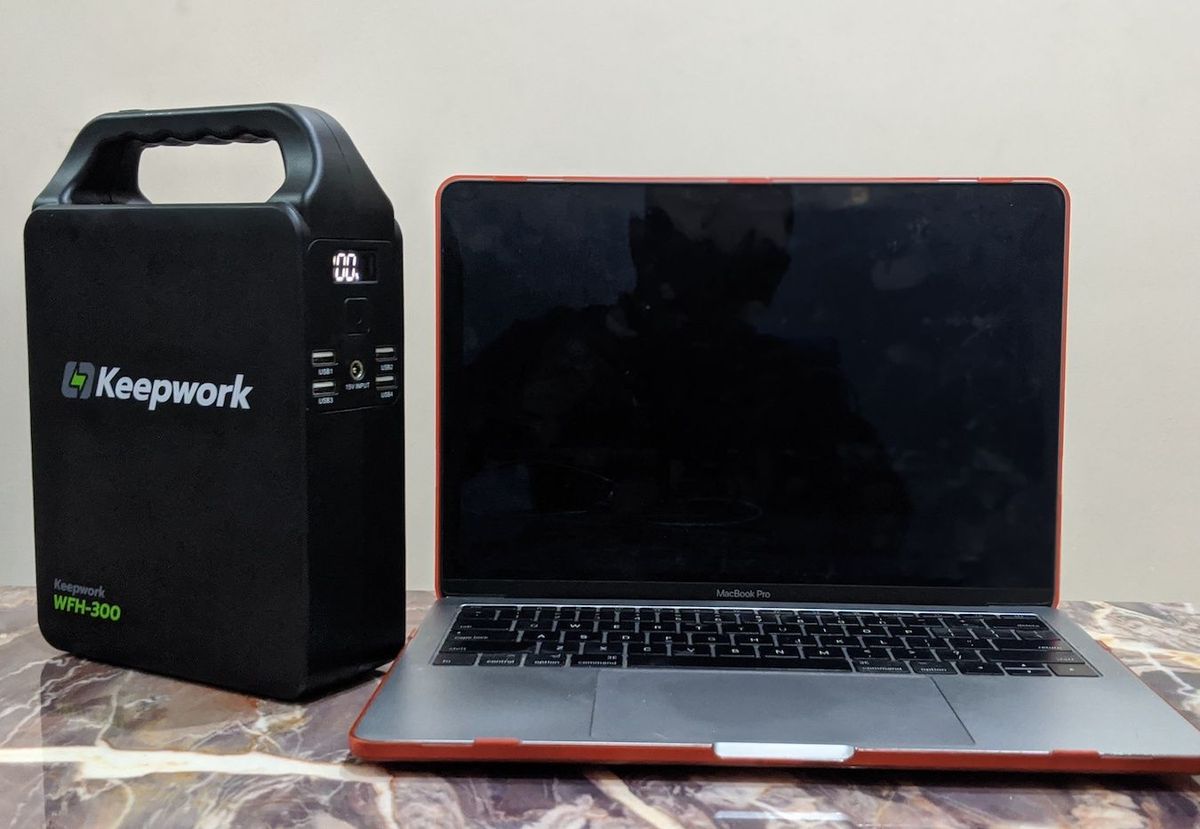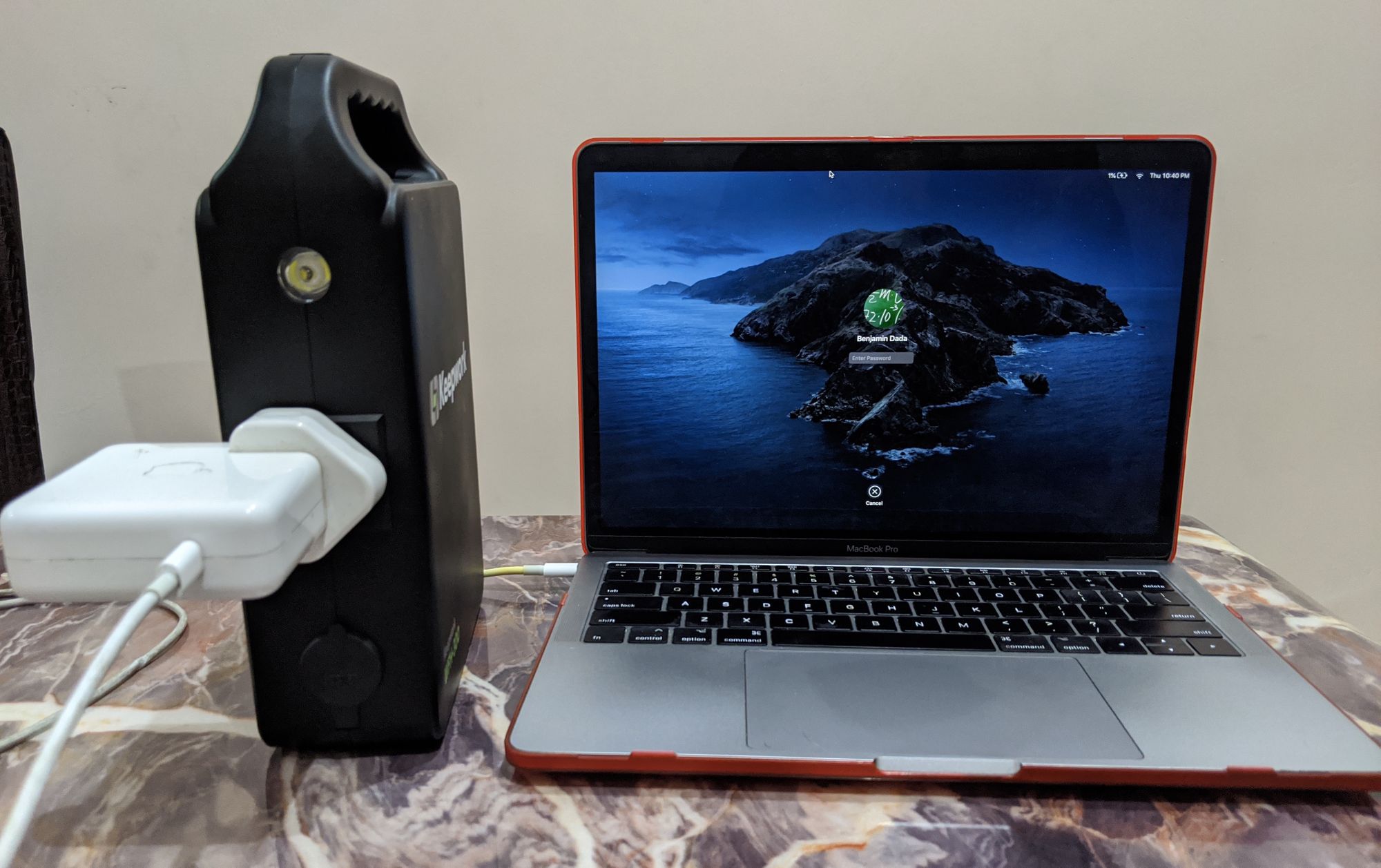Keepwork WFH-300 product review by Benjamin Dada
Benjamin Dada's review of Keepwork WFH-300. Keepwork is a power bank that has the capacity to charge laptops and phones multiple times before dying.

Keepwork WFH-300 is a power bank that I use to charge my laptop and phone while working from home.
A little back story
My name is Benjamin Dada, I'm a young Nigerian living and working in Nigeria's tech and media industry.
In March, my employer instructed us to work-from-home due to Coronavirus.
I do not have any problem working from home. Except that, the instability of my internet and electricity will become more pronounced.
I took care of my shaky internet situation by purchasing MTN's HyNetflex. But I quickly realised that the MTN router has a poor battery life and needs electricity to function.
So, what do I do? Since I do not operate a generator, as my other colleagues, neither do I have an inverter.
Before getting my Keepwork, in shame, I used to pack all my devices to my neighbours' house, for charging. See, I thought I was a big boy because I stayed in an estate with near-constant electricity. But work-from-home has humbled me. Yet, I won't go down without a fight.
Enter Keepwork, my saviour.
New beginnings with Keepwork
My Keepwork kit arrived at my doorstep on May 28, 2020.
Productivity 'bout to go up! pic.twitter.com/tSRT37eIjS
— Benjamin Dada (@DadaBen_) May 28, 2020
The Keepwork kit comprises a power bank (which I will refer to as “Keepwork” itself) and a solar panel. To recharge my Keepwork, I plug it into a wall socket at home. And then, when I need to charge my (electronic) devices, I plug it to my Keepwork. Though, I can't charge my devices on Keepwork while it’s charging. I'm not complaining because that helps to preserve the battery life of my Keepwork. Plus, if I have electricity to charge my power bank, why not plug my devices directly to a wall socket?
Anyway, June 18 (the day I began writing this article), made it three weeks since I've had the Keepwork device. How has it fared?
I'm going to review Keepwork across three metrics—features, battery life, and pricing.
Devices: 13-inch 2017 Macbook Pro, Pixel 3, a Spectranet EVO MiFi and an MTN HyNetflex.
For you to immerse yourself in my review, I'm going to detail a lot of things. For instance, the devices I charge using my Keepwork. In general, it's a range of laptops, phones and Internet MiFi. But specifying which devices, in particular, helps you to sense-check my experience and try to replicate my claims. My devices include a 13-inch 2017 Macbook Pro Laptop, Pixel 3 smartphone, a Spectranet EVO MiFi and an MTN HyNetflex.
Also, don’t bother about the little sprinkles of technical jargon, as this article is very readable.
Features: Keepwork has six available ports for charging
To do this, I compare Keepwork's features and stated capacity to my personal experience.
According to its website, it says that you can charge up to six devices, at once. That is 4 USB Devices, 1 AC Device, and 1 x 12V product. That is true, the USB ports are clustered on one side of the device. While, the AC Device port, which can take three-pin chargers, is on the other side. Below the AC port is the 1 x 12V port for you to plug things like a car charger.
However, it's important to note that all the USB slots are of Type A (USB-A). So, you can't directly plug the charging cord of, say, a Pixel 3, which uses a Type C, into Keepwork.
But that shouldn't be a problem because most people in Nigeria use USB-A devices. Android smartphones carry USB-A charging slots. Except for the newer android models like the Pixel series by Google.

Battery life: How long does Keepwork last?
Short answer: It’s hard to tell. But I experimented and you can read on it further down.
It is hard-to-tell because normally, people barely use it up at one stretch, and once their light gets back, they plug their devices to the main electricity source. While they recharge their Keepwork power bank.
Another reason why it’s hard to tell is that one of the factors that determine how long the battery lasts is, how many devices it’s powering at the same time.
"The Battery level you see when you unplug is the correct one"—Keepwork website
In addition, the battery percentage indicator is not accurate. So, for instance, in one charge, your Keepwork can go down to about 49% and then by the next time you are turning it on, it has gone up to about 58%.
Anyway, the Keepwork team is aware of that Battery Percentage level fluctuation. In their FAQ they said "The Battery % level is based on Battery Voltage which drops more quickly during heavier loads. Our BMS (Battery Management System) smooths this out but inevitably it is an estimate and the level you see when you unplug is the accurate one".
According to Keepwork’s device body, it has the capacity for 78000mAh, 288Wh. And my Macbook Pro has a 61W power adapter and a 14,370mAh (?) battery. So, approximately, if I’m connecting only my Macbook Pro to Keepwork, it should charge it five times. And if it’s a phone, with a battery size usually below 5,000 mAh, Keepwork will charge it multiple times over. P.S—Pixel 3’s battery size is 2,915 mAh.
Finding 1: Keepwork charged my laptop once, and phone over 4x
To experiment, I charged my Keepwork power bank to the fullest. Then, sequentially, I completely drained out my Macbook Pro and my Pixel 3 phone. I, then, used the Keepwork to power both of my devices.
Here is how it performed.
The Keepwork charged my Macbook Pro to a full 100%, using up 51% of its battery. After my laptop became full, I unplugged it from the Keepwork and turned it off.

By the time I turned it back on to charge my phone, the battery level of the Keepwork was now reflecting 58%.
The power bank charged my phone easily, that is, without losing so much stored up energy. And by my phone’s second charge it reflected a battery level of 25%. Once the phone was full, I unplugged it again.
As expected, when I came back to turn it on, the battery level was showing 32%.
It was so hard to keep up this experiment because of the uncertainty of NEPA. My electricity supply could go out anytime. And if I was still experimenting, it meant three things. One, I wouldn’t be able to recharge my Keepwork device. Two, I had to always wait for my test devices to completely run out of battery, like shutdown, before I plugged it into the Keepwork. Three, I couldn’t plug any other devices to the Keepwork.
Guess what? I couldn’t keep up. After my third full phone charge, I had to plug in my MTN HyNetflex router, known for its porous battery. This was because I had a delayed power supply from my electricity provider, Ikeja Electric.
Anyway, I still got another full phone charge from the Keepwork device, making it my fourth. As I write, there is still 8% battery left on my Keepwork.
UPDATE: By 2:10 PM, I successfully drained the Keepwork device. How? NEPA took light, and my laptop's battery was 44%. So, I plugged it to my Keepwork (~8% battery), by the time it died my laptop had gone up to 93%.
Finding 2: I’ve used the Keepwork actively for about 3 hours
Before my stated experiment above, I and my siblings have had to use the keepwork to supplement power outage.
During working hours on a weekday, I recall that my sister was charging her Dell laptop. I was charging the Macbook and we were charging the Spectranet MiFi alongside.
But because there was only one three-pin slot (that is, 1 AC Device slot), we had to take turns to charge our laptops and we both clocked 100%. While getting some charge to power my phone, before NEPA eventually brought the light. In total, I think the Keepwork lasted for about 3-4 hours that day.
Pricing
As a student of economics, whenever I see a price, I do not only think in nominal value but opportunity cost. So, what alternative am I forgoing to purchase the Keepwork as my alternate source of power?
As I mentioned above, for me, it’s between a generator and an inverter.
If you stay alone or live in a compact apartment with few electronics and home appliances, I’m guessing the Firman Sumec with A/C output 220v-1.8kva max should work for you. And that costs ₦55,000 on Jumia. Anything above that, like a 2.9kva or a 3.4kva will take you into the realms of hundreds of thousands of naira.
With a generator, you have to deal with buying fuel, noise, human effort, regular maintenance and repairs. By the time you accumulate the stress and other psychological damage, the cost of the generator goes up.
So, say, we go for a noiseless inverter? Well, that one proves to be too expensive, compared to the generator. My friend was going to install one for ₦250,000, which is two times the price of a generator.
For a tech worker like me that barely watches TV, all I need in a time of lockdown is my laptop, internet and phone. Oh, I also need a fan, sometimes.
So, any electricity source that can power up the above-listed devices works well for me.
At it’s debuting price of ₦180,000, the Keepwork is quite expensive for me. But then, with a discount of 30%, it comes into range at ₦126,000.
Interestingly, Keepwork is doing a promo from now till the end of June that prices it at ₦99,999.
If you do decide to buy the Keepwork use my code: DADABEN. It would make all my stress, testing and reporting on the device worth it. Plus, when you give them my code, you get a discount, regardless of whatever price it’s being sold to the public.
If you've used the Keepwork device, what has your experience with it been like? Let me know on Twitter.







Comments ()